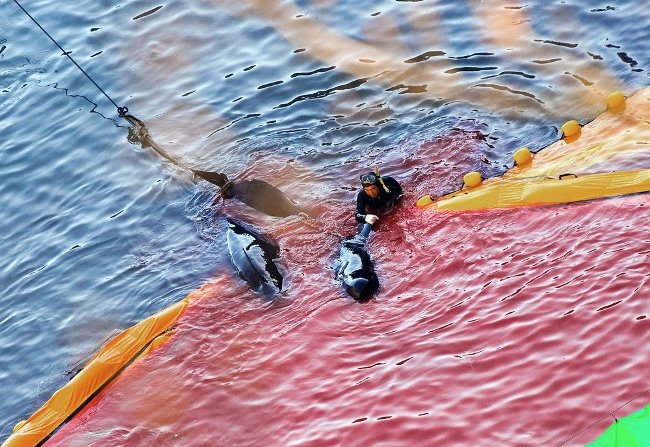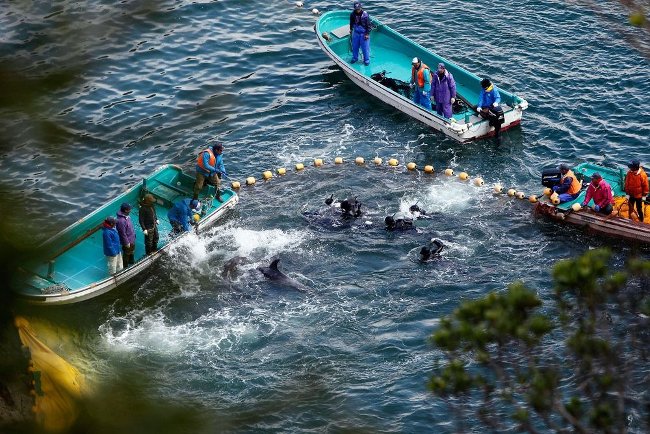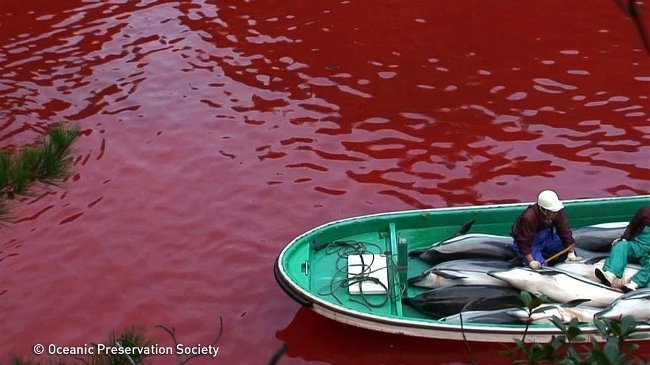'Hunting' season and bloody 'carnage' dolphins in Taiji, Japan
Every time when the " hunting " season and " slaughtering " dolphins in Taiji village in Japan take place, there are about 2,000 smart and close dolphins to the human race who must leave the world.
It is now the start of the most famous and most devastating dolphin hunting season in the small coastal town of Taiji, southwest of Japan. Hundreds of dolphins are cornered in a small bay by fishermen on the boat and then killed for meat or captured to sell to the park with aquariums and ocean gardens around the world. The annual hunting and slaughtering lasts for 6 months, from the beginning of September to the end of February, about 2,000 more dolphins are killed.
The "slaughter" usually takes place in the early morning, before sunrise. A small group of fishermen will receive more than a dozen motor-powered motorboats, then head to the area known to be dolphins residing. As soon as they see the group of dolphins, the fishermen will place some stainless steel columns under the water and use wooden hammer to knock on the metal bar. The noise made the dolphin flutter, causing them to panic and divert into the coves. This helps fishermen fly the bewildered dolphins into an " cove " of the bay that has been surrounded. When the dolphin flock inside, the bay door will be sealed with meshes of dolphins inside.
 Photo source: Japan Times
Photo source: Japan Times
When being driven into the bay, dolphins are still too excited to be slaughtered. So fishermen will let them stay in the bay and calmly return overnight. The next morning, the group of fishermen entered the bay with small boats and began " slaughtering " the dolphins at the same time. In the past, fishermen used sharp hooks and iron spears to pierce each dolphin to death, causing their blood to flow out, the entire water in the bay turned red.
Opposition and condemnation against this custom forced village fishermen to use another " brutal massacre " technique. Currently, dolphins are " massacred" with a long metal rod that hits the neck, breaking the brain stem and destroying them in a matter of seconds. In fact, those dolphins still suffer in a few minutes. The fishermen in Taiji village pushed the wooden cork into the dolphin's wound to prevent blood from flowing into the bay and avoid making the bay water red. These actions look very offensive , cruel and inhumane .
In addition to the physical pain, the dolphin population also suffers from extreme mental pain. Hunters will often only "kill" mature, meaty dolphins and keep small ones. Although the dolphins are left out of danger, they are physically injured, greatly influenced by the brutal massacre. Moreover, they rarely survived for a long time without the support of their kind. Although this group of dolphins is just a random collection of dolphins, most of them will build a dolphin family with close relationships. When the dolphins in the group are massacred, the rest of the group will be sad and painful like humans.
 Photo source: Nat Geo
Photo source: Nat Geo
This horrific massacre was secretly returned by National Geographic photographer Louie Psihoyos in 2009 for the American documentary "T he Cove " - describing the process of Taiji town hunters. Dolphins for business purposes - won the Orsca prize. Since the documentary was released, the dolphin hunting season in Japan has attracted special attention of public opinion, causing outrage for many people around the world. Millions of people, livestock activists along with organizations have asked to stop this " emotionless action " again. But this is not possible, because this is a multi-million dollar industry, supported by the Japanese government.
The Japanese government has issued permits to hunt dolphins, whales and other marine animals. Approximately 1,800 licenses for dolphin hunting are issued each year. Just like dolphins and other small whales, the total number of paper issued in the hunting season alone is more than 16,000. This is a significant drop, from 23,000 licenses issued each year at the time of the documentary.
The demand for dolphin consumption dropped sharply due to efforts from NGOs and activists popularized by the Japanese people about the dangers of eating mercury-contaminated dolphin meat. In 2015, the World Association of Zoos an Aquariums (WAZA ) also banned the sale of dolphins, after controversy over slaughtering and hunting, protests and pressure from world organizations. But there still exists a large number of marine parks not under the management of Waza , ready to buy dolphins from Taiji village, Japan.
 Source: Wikipedia / Save Dolphins / Huffington Post / Australia for Dolphins
Source: Wikipedia / Save Dolphins / Huffington Post / Australia for Dolphins
Below is a video recording the " hunting " season and " slaughtering " dolphins in Taiji, Japan:
You should read it
- Why do hundreds of whales and dolphins 'collective suicide'?
- Did you know: people and pigs have the same skin structure, human nervous system and round worms are the same ...
- 10 incredible facts about languages - how animals communicate
- Endangered white dolphin in Mexico
- Animals can be surprisingly humanoid: rats can drive, dolphins dream ...
- Cheetah hunting newspaper sped up 0-95km / h in 3 seconds to defeat the spectacular prey
 Is Proxima b our 'neighbor' planet?
Is Proxima b our 'neighbor' planet? Water can 'cut sweet' concrete and steel. Do you believe that?
Water can 'cut sweet' concrete and steel. Do you believe that? Why have scientists found Proxima b - '2nd Earth' until now?
Why have scientists found Proxima b - '2nd Earth' until now? Learn about how to build houses in a few dozen hours, life expectancy of several decades
Learn about how to build houses in a few dozen hours, life expectancy of several decades Successful production of Eco-Eco rice reduces climate change
Successful production of Eco-Eco rice reduces climate change How is the world's largest bank secure?
How is the world's largest bank secure?